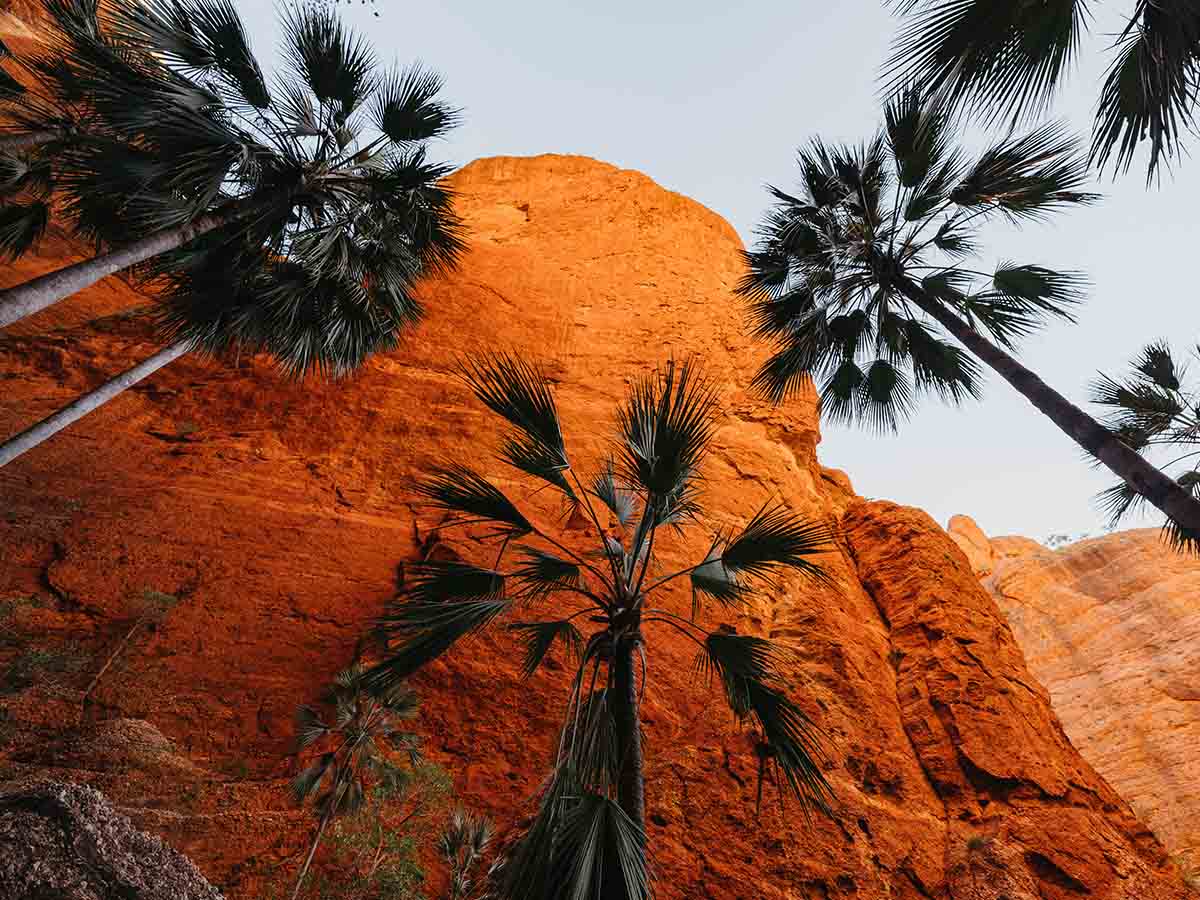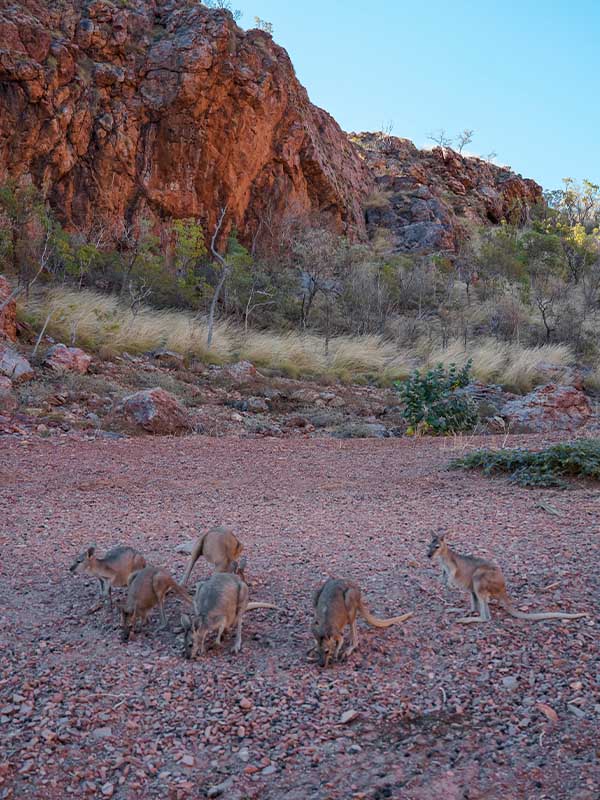20 April 2023
![]() 6 mins Read
6 mins Read


The spectacular King George Falls. (Image: Tourism Australia)
Lurking through the looming rock domes of the Bungle Bungles by moonlight is not something that happens on a regular basis. In fact, I’ve had to cajole my guide to take me under the night’s blanket of Kimberley stars. Still, his eyes did light up at the suggestion and now I see why. Totally alone, we follow a dirt path between rugged 350-million-year-old forms. Hundreds of them have been sculptured and horizontally banded in black and orange by the greatest artist of all, Mother Nature. Some rise 300 metres tall, throwing huge oval shadows emboldened by the full moon.

Boab trees dot the horizon at sunset near Kununurra. (Image: Tourism Western Australia)
Purnululu National Park, which holds the Bungle Bungle Range and thoroughly deserves its UNESCO World Heritage status, feels about as remote and raw as it gets. Yet it’s only about 300 kilometres from Kununurra, the eastern Kimberley’s civic hub. The outback town of 5000 people is lined with saffron-red dirt, facing a lake rippling with barramundi and surrounded by fields of chia, sandalwood and mango trees. It’s a place that isn’t fancy or posh; instead, it garners instant affection for being its true-blue self. Even the pink diamond boutiques (the world’s rarest diamond was mined nearby until 2020) are unpretentious.

Kununurra is a place that deserves more attention. (Image: Tourism Western Australia)
Despite its many wonders – from dramatic waterfalls to hideaway gorges and the largest island-studded lake in the southern hemisphere – Kununurra remains under the radar for most Australians. Hit by the COVID-19 yo-yo – forgotten in 2020, swamped in 2021, and now fearful of the impact WA’s unpredictable borders might have in 2022 – Kununurra is a place that deserves more attention. Even, if you ask me, equal billing with its dramatically different neighbour, beachy, buzzy Broome. So, let’s get acquainted.

Marvel at the Bungle Bungle Range in Purnululu National Park. (Image: Tourism Western Australia)
While driving into the Bungle Bungles from Kununurra is a top-shelf adventure, flying comes with the bonus of understanding the scale of the rock forest from above. Most aerial tours take in Lake Argyle, the aforementioned lake so big it inundated more than 70 mountains when it was dammed, turning them into uninhabited islands. I’ve opted for a special chopper jaunt that includes a James Bond-style landing on one of the isles’ elevated sides. I emerge to wrap-around views of flat, velvety water, rubbly red islets and glimpses of the nearby resort’s famous infinity pool. The pilot is a local, sporting the regional uniform of cobalt workman’s shirt and subdermal tan, and he’s clearly at home touching down anywhere I point. He tells me pilots come from everywhere to supercharge their flying hours in Kununurra; the airport is a hive of light aircraft, float planes and helicopters.

An aerial view of the El Questro Homestead located on the Chamberlain River, near Kununurra. (Image: Tourism Western Australia)
I take his word for it and join a scenic flight over the King George Falls, twin cascades that plummet 100 metres down, flanked by dramatic red cliffs. From above, I can trace the waterway winding inland through the vast, boab-dotted landscape, collecting the wet season’s abundant rains before dumping them over the edge. We land just beyond, at the bush hideaway, Faraway Bay. The solar-powered retreat, rebuilt after a wet-season cyclone in 2005, is relatively simple given its nightly price tag. But as I relax into the casual Kimberley vibe, I realise it’s an exact fit for this barely populated wilderness. Overlooking an empty beach (save for a resident croc or two), the handcrafted dipping pool and swinging hammock become coveted spots when I’m not hiking through scrub to rarely seen rock art or sitting around the campfire talking food with the chef.

Chart the course of the Lower Ord River with HeliSpirit.
One day, we boat along the King George River, reaching the falls some 12 kilometres in. This time we’re at toe level, an entirely different and rather humbling perspective. The vessel nudges up to the splintering water and we allow ourselves to be saturated with heavy, gravity-bound droplets. It’s thrilling.

Take the iconic drive along the Gibb River Road to El Questro.
Before I move on, I have to share Faraway Bay’s other little secret: the spring-fed showers. Essentially a water tank with no roof and open to the front, each private outdoor ‘en suite’ spells out the freeing nature of the Kimberley’s secluded environment. Showering gleefully by night as I’m enveloped by black amplifies the Milky Way to a brightness I can’t tear my eyes from.

Meet the local wildlife at Lake Argyle. (Image: Tourism Western Australia)
Returning to Kununurra, I round off my epic exploration with a 4WD trip to El Questro Station, which lies 110 kilometres away, off the rough-and-ready Gibb River Road. The drive alone captivates: the Cockburn Ranges, which have been likened to a rock fortress, gaze down in weathered red greatness, moving behind us as we turn to rev through the Pentecost River. Opposite is the vast cattle station turned wilderness park, loved for its multi-tiered access: exclusive at the homestead, casual at the station and basic in the campgrounds. The lure is, of course, nature, with gorges, cliffs and springs open to all. Its egalitarian nature is very Kununurra, and spreads to guests who greet each other on hikes and chatter beside waterholes. Like its setting, it is a special, spirited place, one that deserves everyone’s attention.

See the captivating Cockburn Ranges. (Image: Tourism Western Australia)
You can fly direct to Kununurra from Perth, Darwin and Broome with Airnorth and Qantas.
While in town try Freshwater Apartments, then 4WD to El Questro and fly to Faraway Bay.
Must-tries include local mango smoothies and anything with chia seed and boab tuber. Head to Wild Mango Cafe & Gelato for lunch and Hotel Kununurra for dinner in the beer garden.

Up and away with HeliSpirit.
Take a Helispirit chopper adventure and scenic flight with Aviair or Kingfisher Tours.
Kununurra is at the eastern tip of the Gibb River Road. It enjoys two distinct seasons: the dry (April to October) and the wet (November to March). As you’d expect, the dry is clear, sunny and toasty while the wet, commonly known as ‘waterfall season’ here, is a hot and humid period of lightning storms, downpours and rushing waterfalls.

The Bungle Bungle Range, lit up by the starry night sky (Image: Tourism Western Australia)
The small sister town of Wyndham is also worth a mention. They have the Croc bakery (where you can get Crocodile or Barramundi pies) and Port Wyndham has lots of local history. The caravan park here is also a gem. Clean and thoughtful facilities and friendly staff make your stay very pleasant and I also boasts a 2000 year old Boab tree! Well worth a visit.
Came up to kunanurra for a few months stayed 7 months. It caught my heart.just love it here.sad to be leaving but must move on.enjoy what the town and surrounds have to offer.